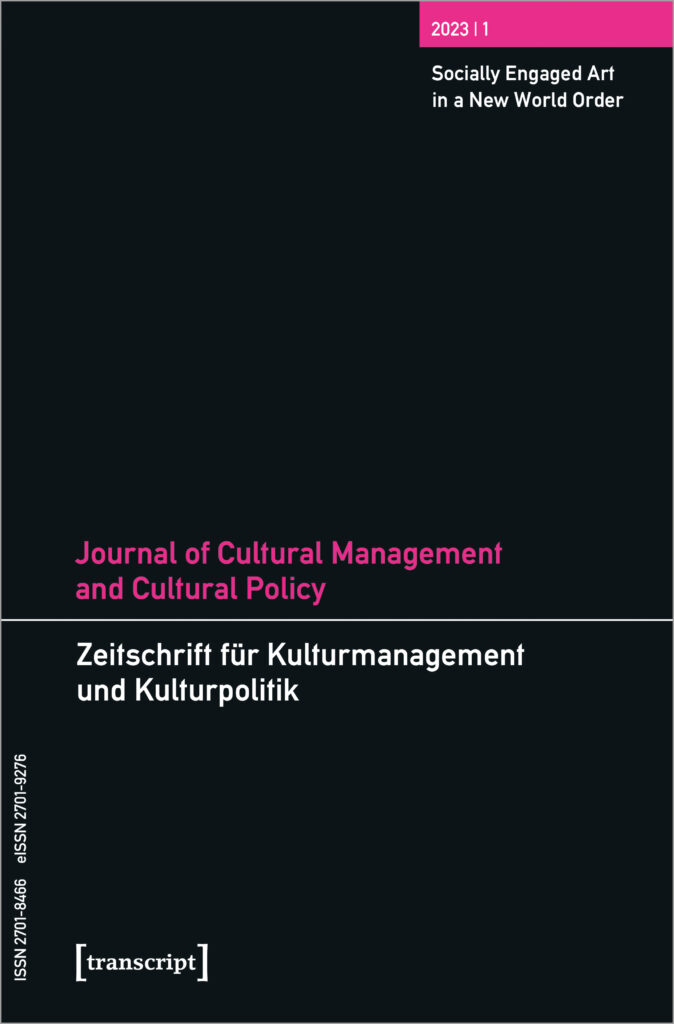Editorial
Socially Engaged Art’s Histories and Tactics for the Neoliberal Era. Karen van den Berg and Melissa Rachleff Burtt in conversation with Angela Dimitrakaki and Nomusa Makhubu
Abstract
The conviction that art is capable of shaping and experimentally developing new social forms and new ways of living together is as old as the artistic avant-garde. The social situatedness of art and the interplay between artists, non-artists, institutions, and policy makers have changed considerably in the twenty-first century. Socially engaged art is broadly accepted as a new discipline or even a new field unto itself and is considered the generator of new social formations, transdisciplinary collaborations, and learning-through-participation pedagogies, due to how socially engaged artists operate. For example, communities that want to improve the social fabric of a neighborhood, to make it more livable and socially just typically follow a logic outside of art. Socially engaged artists have recognized the importance of community-building, and for that reason incorporate practices adopted by political activists and social workers. Museums are attracted to the community-building effects at the heart of socially engaged art and increasingly invite socially engaged artists and activists to produce projects for their audiences or—better—public. Indeed, the International Council of Museums (ICOM) advocates changing the definition of museums to “a platform for questioning and celebrating heritage and collections” and that they embrace “inclusive and polyphonic spaces for critical dialogue about pasts and futures” (ICOM 2019). Additionally, the Belfast-based, Northern Irish group, Array Collective won the 2021 Turner Prize in the U.K., and in 2022, the documenta exhibition in Germany was organized by Indonesia-based collective ruangrupa from Jakarta. It is clear that socially engaged art is now part of the cultural mainstream. Yet this is not a time to be complacent. To be embraced by the mainstream risks fetishization. Rather than producing actual social change, socially engaged projects for museums, biennials, and art fairs remain in the art field and so might not offer a catalytic experience to remake the world…
© 2026, Journal of Cultural Management and Cultural Policy
Keywords
- Aesthetics
- Higher Education
- Cultural Diplomacy and Foreign Cultural Policy
- Occupation
- Career and Professional Role
- Audience Development
- Audience Studies and Visitor Studies
- Visitor Motivations
- Business
- Covid Pandemic
- Democracy
- Digitalization
- Diversity
- Third Sector
- Empirical Aesthetics
- Development
- Ethics
- Evaluation
- Field Theory
- Festival
- Film
- Federalism
- Community Arts
- Societal Change
- Ideology
- Staging
- Career
- Communication
- Concert
- Creative Industries
- Creativity
- Crisis
- Culture
- arts organizations, cultural organizations
- Cultural Participation
- Cultural Change
- Fincancing The Arts
- Cultural Promotion Law
- Cultural History
- Cultural Management
- Cultural Economy
- Cultural Organizations
- Art Education
- Cultural Policy
- Cultural Production
- Cultural Sociology
- Art Education
- Cultural Understanding
- Arts Administration
- Cultural Industry
- Cultural Sciences
- Art
- Art Field
- Arts Research
- Artists
- Artistic Research
- Artistic Reputation
- Arts Management
- Arts Organizations
- Art education
- Arts Marketing
- Arts Administration
- Curating
- Leadership
- Literature
- Advocacy
- Management
- Marketing
- Market
- Media
- Methods Development
- Mexico
- Monumentalizing
- Museum
- Music
- Non-Visitor Studies
- Opera
- Orchestra
- Organization
- Political Expression
- Post-truth Politics
- Professional Role
- Audience
- Audience Development
- Law
- Government
- Role
- Socially Engaged Art
- Social Cohesion
- Social Change
- Social Cohesion
- Non-visitor Socio-demographics
- Socioculture
- State
- Symbolic capital
- Dance
- Participatory Justice
- Theatre
- Theatre Governance
- Theory Development
- Tourism
- Transformation
- Survey
- Entrepreneurship
- Urbanism
- Civil Society



